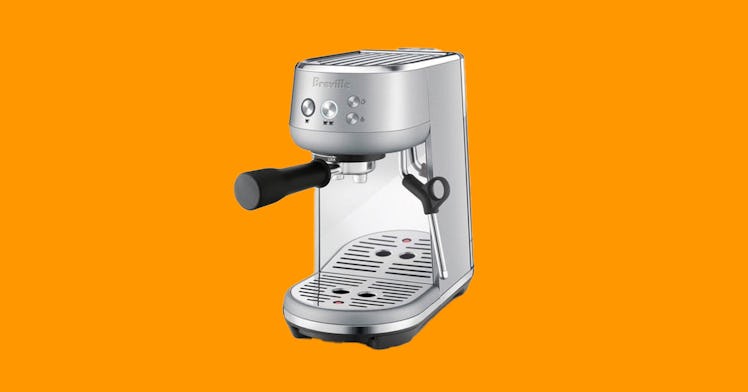This Breville Espresso Machine Turns You Into a Pro Barista
It's ready to go in three seconds.

For many, brewing a decent cup of coffee at home is achievable, especially with the practice you’ve put in over the pandemic. You can spend the morning doing it pour-over style, French press it, or rely on a trusty drip machine. The point is, visiting a café for a coffee fix isn’t a necessity—it’s a luxury you don’t have time for when the kids need breakfast. Espresso is different. Espresso is glorious yet it’s also a glorious pain in the ass.
Making espresso at home typically requires dedication, which you might have, and the training you don’t. The good machines tend to be spendy, and then you’ll need a proper burr grinder, and a system for storing beans, fancy little cups—you get the idea. If you’ve watched a skilled barista make espresso, the knobs, levers, banging, and hissing steam can make it look like they’re working on a WWII submarine.
We tried to shortcut all of that with the Breville Bambino. The good news is that while a barista can certainly pull a better shot than you can from this machine, it significantly evens out the work:enjoyment ratio. The Bambino isn’t cheap, but it’s comparable to other machines out there, and best of all for harried parents, it’s fast.
With some practice and a few so-so shots, you can make a good espresso with a nice crema layer and a rich, balanced taste that lingers. The Bambino’s footprint is pretty tidy at about 8×12-inches, or the size of a toaster, and it tucks in below upper cabinets. We parked it next to our grinder. You don’t need a grinder, but if you’re going through the trouble of making espresso at home, you should invest in a grinder. It’ll boost your regular coffee game too.
For all the wizardry around making espresso, the Bambino’s process is pretty straightforward. Fill the filter basket with a few grams of coffee. Drop that into the portafilter (the handle) then press on the grounds with a tamper. Twist the handle into the machine, press a button, and wait for about 15 seconds. That’s it.
If you did it correctly, the shot will start pouring in about 12 seconds, with the consistency of warm honey. If your shot is pouring faster than 12 seconds, try reducing the grind size. Do the opposite if the shot takes longer than about 13 seconds to start pouring out. You should expect to fuss with this machine and spend time tweaking your setup. Plan on adjusting the size of your grind, the number of grams you grind, and your tamping technique.
The Bambino uses a boiler that heats the water quickly to about 200 degrees with an even nine bars of pressure, which is the secret to good espresso. The boiler is robust enough to go from heating the water for the shot to immediately moving over to steaming the milk. So there’s no lag time.
The machine’s not without faults though. The tamper is plastic, when it feels like metal would have been the obvious choice. The markings on the tamper, which are supposed to align with the top of the filter basket after you press down, could be easier to see. You’ll want to run the machine for a shot or two without any coffee in the filter to prime the pump and warm the portafilter up. Frequently we found this often releases grounds stuck to the head from the previous shot. Before you steam milk, you’ll want to run the wand into a rag to let out any trapped water, which would otherwise go into the milk.
But all told, this is a great investment: It’s easy to use, easy on the eyes, and easy(ish) on the wallet.
Every product on Fatherly is independently selected by our editors, writers, and experts. If you click a link on our site and buy something, we may earn an affiliate commission.
This article was originally published on